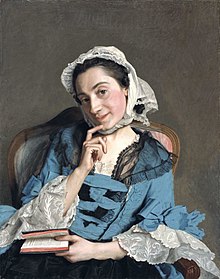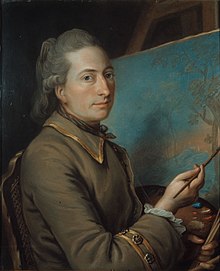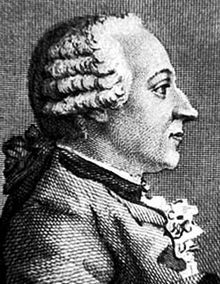Louise d'Épinay

Louise Florence Pétronille Lalive, marquise d'Épinay , better known as Madame Louise d'Épinay (born March 11, 1726 in Valenciennes , Nord-Pas-de-Calais , † April 17, 1783 in Paris ) was a French writer and well-known salonnière . Madame d'Epinay is known for her friendships with the writers Jean-Jacques Rousseau and Baron von Grimm , and her acquaintance with Denis Diderot , Jean Baptiste le Rond d'Alembert , Paul Henri Thiry d'Holbach ,Voltaire , Théodore Tronchin and other French writers.
Live and act
Louise Florence Pétronille Tardieu d'Esclavelles was the daughter of Brigadier General of the Infantry and Governor of the Citadel of Valenciennes Louis-Gabriel Tardieu, marquis d'Esclavelles (1666-1736) and his wife Florence Angélique Prouveur de Preux (1695-1762). Her cousin was Elisabeth Françoise Sophie de Tardieu d'Esclavelles, Comtesse d'Houdetot . At the age of nine, Louise lost her father and was from 1736 under the tutelage of the French King Louis XV. in the abbey Fontevrault educated.
On December 23, 1745 she married her cousin (2nd degree), the principal tenant Denis-Joseph Lalive, Marquis d'Épinay (1724–1782), the second son of Louis Denis Lalive de Bellegarde (1680–1751) and Marie Thérèse Josèphe Prouveur (1696-1743). Louis Denis Lalive de Bellegarde was a Fermier général and was relieved of his lucrative post in 1762. Her sister-in-law, Élisabeth Sophie Françoise César, comtesse d'Houdetot (1730–1813), was a famous salonnière of the 18th century. The marriage, which was reportedly unhappy, resulted in two children:
- Louis-Joseph Lalive d'Épinay (1746–1813)
- Françoise-Suzanne-Thérèse Lalive d'Épinay (1747–1748)

After the birth of their second child, Madame d'Épinay left her husband after bitter arguments because she no longer wanted to tolerate his relationship with his lover. A little later she entered into a long love affair with the writer Charles Louis Claude Dupin, seigneur de Francueil (1716-1780). He was married to Maria Aurora von Sachsen (1748-1821), the illegitimate daughter of Hermann Moritz von Sachsen , and thus the great-grandfather of the writer Aurora Dupin, better known as George Sand . The relationship with Madame d'Épinay resulted in two children:
- Angélique-Louise-Charlotte Le Blanc de Beaulieu (1749–1824)
- Jean-Claude Le Blanc de Beaulieu (1753-1825), Bishop of Soissons (1802 to 1820) and then Bishop of Arles

In 1746 Jean-Jacques Rousseau (1712–1778) became secretary in the Dupin-Francueil house. Two years later (1748) he made the first acquaintance with his future patron, Madame d'Épinay. Friedrich Melchior was probably introduced to Baron von Grimm in 1754 by Rousseau to Madame d'Epinay, whose lover he soon became.
Madame d'Épinay ran a well-known literary salon in her Paris city apartment , and her guests included Pierre Carlet de Marivaux , Charles Pinot Duclos (1704–1772), Jean-François Marmontel , Charles de Secondat, Baron de Montesquieu , Jean-Nicolas Dufort de Cheverny (1731–1802), Michel-Jean Sedaine , Jean-François de Saint-Lambert , Abbé Galiani and Guillaume Thomas François Raynal .
She was friends with Jeanne-Catherine Quinault , who in turn had an intimate relationship with Denis Diderot around 1769.
As a writer , Madame d'Épinay mainly used the genres diary and letter . It is thus typical of women's literature that flourished in the 18th century and preferred small, more intimate forms. The value of her work, however, results not only from the documentation of historical and cultural events, but also from Madame d'Épinay's brilliant style and her political foresight.
Prix d'utilite of the Académie française
Shortly before her death, Louise d'Épinay received the Prix d'utilite of the Académie française (1783) for her work Conversations d'Émilie . The conversations were translated into several languages. They are considered an alternative to Rousseau's educational novel Emilie (1762), which deals with the education of girls solely in preparation for their later role as housewife, mother and husband's companion.
Works (selection)
- 1774 Les Conversations d'Émilie (translated into several languages)
- 1818 Correspondance de l'abbé Galiani
literature
- Hellebriefe / Ferdinando Galiani and Louise d'Epinay (Correspondence), translated from the French by Heinrich Conrad. With an introduction and remarks by Wilhelm Weigand , supplemented by Friedhelm Kemp , Frankfurt am Main: Eichborn 1992, ISBN 978-3-8218-4096-3 , Die Andere Bibliothek series .
- Annette Mohr: Madame d'Epinays conception of the education of girls in the context of women-specific education tracts of the 18th century in France (SOFIE. Saarländische Schriftenreihe zur Frauenforschung; Vol. 7). Röhrig Verlag, St. Ingbert 1997, ISBN 3-86110-144-0 (also dissertation, Saarbrücken University 1995).
Web links
Individual evidence
- ↑ Genealogy
- ^ Genealogy of the Lalive de Bellegarde
- ^ Jean-Jacques Rousseau: Confessions. Translation Ernst Hardt, Insel Verlag TB 681 (1985) ISBN 3-4583-2523-9 , p. 681
- ↑ Margot Brink: “Having a will of your own seemed like a crime to me. Louise d'Epinay 1726–1783. ”Reading on November 30, 1993 in Bremen. See the festival catalog “... you appreciate women!”, Pp. 88–91.
| personal data | |
|---|---|
| SURNAME | Épinay, Louise d ' |
| ALTERNATIVE NAMES | Tardieu d'Esclavelles, Louise Florence Pétronille |
| BRIEF DESCRIPTION | French writer |
| DATE OF BIRTH | March 11, 1726 |
| PLACE OF BIRTH | Valenciennes , Nord-Pas-de-Calais |
| DATE OF DEATH | April 17, 1783 |
| Place of death | Paris |

